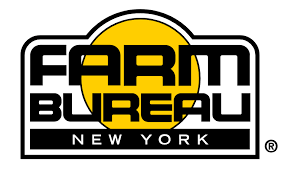Nostalgia on the race track
On assignment with photographer Walter Horylev:
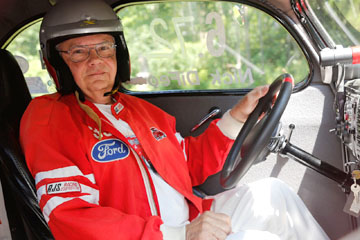 At 69, Parma resident Nick DiFeo is ready for drag racing in his 1939 Ford Coupe. He’s won the points total competition at Empire Dragway in 2010 and 2011 and came in third in 2012.Linda warned me to get out of the garage when Nick DiFeo started his 1939 Ford Coupe dragster; the noise would be deafening, and it was. Parma resident Nick moved his dragster out for picture taking and it was awesome. It’s a bright red color and in excellent shape. Purchased in 1979, he decided to build it into a 1950s to early ’60s style Gasser that would, hopefully, be competitive in the 1980 and ’90 bracket and nostalgia racing environment.
At 69, Parma resident Nick DiFeo is ready for drag racing in his 1939 Ford Coupe. He’s won the points total competition at Empire Dragway in 2010 and 2011 and came in third in 2012.Linda warned me to get out of the garage when Nick DiFeo started his 1939 Ford Coupe dragster; the noise would be deafening, and it was. Parma resident Nick moved his dragster out for picture taking and it was awesome. It’s a bright red color and in excellent shape. Purchased in 1979, he decided to build it into a 1950s to early ’60s style Gasser that would, hopefully, be competitive in the 1980 and ’90 bracket and nostalgia racing environment.
The Kodak retiree worked on the design and construction during 1980-1985, doing sandblasting, body work, painting, wiring, changing the engine, transmission and rear axle, and has been racing and fine-tuning it ever since. He has raced in many western New York tracks over the past 20 years and, in recent times, has concentrated on the nostalgia events on the east coast.
Nick stated: “It all started when my father bought a 1940 Ford back in 1956. I modified it and did some racing with it over the years until I bought the 1939 Ford Coupe. Then I retired the other Ford to a street car.”
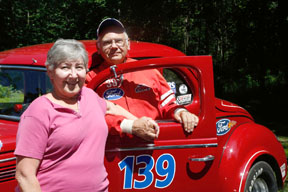 Nick, his car and his companion and crew chief, Linda Kaiser.He’s been racing at Empire Dragway in Leicester, New York on Saturday nights for the past six years in the Nostalgia Gasser Racing Series class (run like the events held in the 1960s) and has done very well, winning the points total competition in 2010 and 2011 and coming in third in 2012.
Nick, his car and his companion and crew chief, Linda Kaiser.He’s been racing at Empire Dragway in Leicester, New York on Saturday nights for the past six years in the Nostalgia Gasser Racing Series class (run like the events held in the 1960s) and has done very well, winning the points total competition in 2010 and 2011 and coming in third in 2012.
This class consists of pre-1966 cars using leaded gas with an octane rating of 110 straight from the pump at the track. Nick races in the ten competitions, held between May and the end of September, against about 50 other persons and looks forward especially to the Gold Cup test in August.
He explained the details of Nostalgia drag racing. Find your opponent and get into line as a pair. (There are two lanes used at Empire and they are about a mile long, so there’s a good length to coast after traversing the one-eighth mile of the race). They travel through a track sprayed with water, apply the brakes and spin the tires in low gear, then in high gear, (this warms the tires up so that they get sticky and gain traction), release the front brakes and sneak up on to the photocell beam signifying the start line.
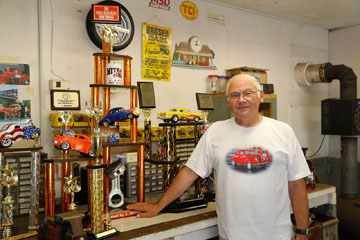 Nick DiFeo and his collection of drag racing trophies. He’s especially proud of his 2010 and 2011 first place awards at the back of this display. When both cars are lined up and the transmission is locked, the tower lights go on, three yellow lights blink, spaced a half second apart, followed by the green light. In that split second, anticipating the green, the cars take off with a roar and squealing tires. Starting off in low gear, and about 3,000 RPMs, the transmission brake is released and the driver simultaneously floors the gas pedal. When the RPMs hit 6800 he shifts into high gear.
Nick DiFeo and his collection of drag racing trophies. He’s especially proud of his 2010 and 2011 first place awards at the back of this display. When both cars are lined up and the transmission is locked, the tower lights go on, three yellow lights blink, spaced a half second apart, followed by the green light. In that split second, anticipating the green, the cars take off with a roar and squealing tires. Starting off in low gear, and about 3,000 RPMs, the transmission brake is released and the driver simultaneously floors the gas pedal. When the RPMs hit 6800 he shifts into high gear.
In less than seven seconds and after hitting a speed of about 100 mph, the race is over. As Nick exclaimed: “There are two things that are very important: leave the starting line on time and get to the finish line first without going under your predetermined time.” If you leave the starting gate too soon or end up at the finish line sooner than you predicted, you lose. Incidentially, the driver who estimates a slower predetermined run time gets spotted the difference in time at the start.
“You really have to know your car,” says Linda.
Nick won the Nostaliga Gas class championship in 2010 and 2011 in his late 60s – quite an accomplishment.
Linda added, “In those two years Nick and his car were in total synchronization.”
To anticipate what your travel time is, sometimes to a thousandth of a second, this is where the crew chief can help. Linda collects all the data on track conditions and climate factors, (wind, temperature, humidity, etc.) and performance from the three practice runs the drivers can take on the day of the races. Throw that into the pot and you can see that it’s a contest involving physical and mental capability. For instance, in a recent race, Nick lost to a driver who estimated his race time at 6.62 seconds and came in at 6.625 seconds; five thousandths of a second off. Nick was off by eleven thousandths of a second and lost.
The winner pairs off with other winners, two-by-two in a single elimination contest, until a final winner emerges for that day.
The races start around 6 p.m. and end around 11 p.m. As Linda pointed out, there’s social time also, that she enjoys very much. People sit and talk and watch and eat, picnic style, for a $5 donation and a dish to pass. As stated by Frank Zieminick, Promotions Director (and confirmed by Linda), “I enjoy the camaraderie and the racing and family atmosphere that we attract.”
Revitalized Project House showcases historic features
by Kristina Gabalski
 The revitalized house at 65 Fayette Street in Brockport. With her first house “revitalization” now complete, Brockport Village Trustee Carol Hannan says the project “shows what you can do (with a condemned property) other than turn it into a derelict rental.”
The revitalized house at 65 Fayette Street in Brockport. With her first house “revitalization” now complete, Brockport Village Trustee Carol Hannan says the project “shows what you can do (with a condemned property) other than turn it into a derelict rental.”
Work was recently completed on the “Project House” at 65 Fayette Street in the village and an open house was held Saturday, July 20 to show off the transformation. Hannan said she expected to put the 1,750 square feet home on the market the week of July 22.
The area where the house is located – in the village’s northeast quadrant – has suffered especially from abandoned and vacant properties, Hannan says.
She hopes to use profits from the sale of the house to continue the “revitalization” program of abandoned and run-down homes in the village.
“This village is a treasure-trove of houses waiting to be rehabbed,” she says.
The transformation from condemned house to a turn-key property with all the modern amenities, while still remaining faithful to the historic nature of the house – which was built sometime around the 1830s – is evident.
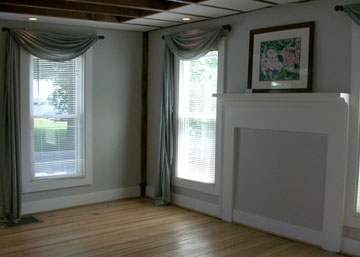 The living room in the oldest part of the house (the front) has exposed beams in the ceiling. The fireplace was never finished for use as a fire place – only the mantel is there. At one time a pot-bellied stove was used in this room for heat. “It was a labor of love,” Hannan says. “We tried to do right by this house and the next people who own it.”
The living room in the oldest part of the house (the front) has exposed beams in the ceiling. The fireplace was never finished for use as a fire place – only the mantel is there. At one time a pot-bellied stove was used in this room for heat. “It was a labor of love,” Hannan says. “We tried to do right by this house and the next people who own it.”
The house has vinyl siding, a new roof and gutters as well as new energy efficient windows, drywall and paint, electric and security system, insulation, plumbing, a modern eat-in kitchen with microwave, dishwasher and laundry hook-ups, a high efficiency hot water heater and 1-1/2 baths.
The up-to-date-code compliant features and amenities make the home appealing to today’s buyer, but an effort was also made to showcase the house’s history. A corner hand-hewn beam and beams in the living room ceiling have been left exposed to add interest and to showcase the home’s solid, no-nails, post and beam construction. Hardwood floors have been uncovered, refinished and brought back to life and the “crooked door” in the large family room remains intact.
Hannan says Charles Farmer made the addition to the back of the original house to use for his workshop. Farmer was a cobbler and the room – which could now be used as a family room – was built with a definite slope, still notable in the crooked door frame that leads outside to a new deck.
The Brockport Historic Preservation Board has designated the house a Historic Landmark.
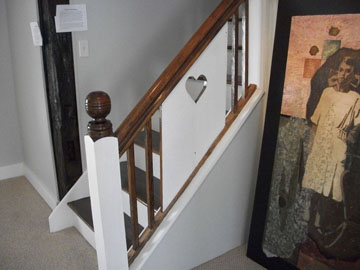 The stair railing/newell post was crafted by Brockport Police Chief Varrenti. The beam has been left exposed. Many community members volunteered their time and skills during the rehab including Brockport Police Chief Daniel Varrenti, who installed the security system and crafted a newell post and stair railing with wood found in the house. Volunteer Bill Johnson used his skills to make an old door – discovered inside a wall in the house – work again as a welcoming front door.
The stair railing/newell post was crafted by Brockport Police Chief Varrenti. The beam has been left exposed. Many community members volunteered their time and skills during the rehab including Brockport Police Chief Daniel Varrenti, who installed the security system and crafted a newell post and stair railing with wood found in the house. Volunteer Bill Johnson used his skills to make an old door – discovered inside a wall in the house – work again as a welcoming front door.
The stair railing made by Chief Varrenti includes a center panel with a heart shape cut-out in the middle. The heart symbolizes that the house was rehabbed, “with loving care,” Hannan says.
“I’m ready to send the house on its way to a loving family,” she adds, “it’s ready for the next 175 years.”



